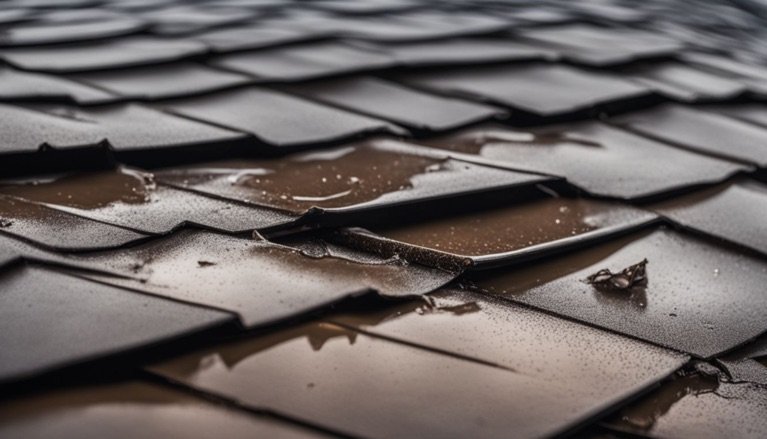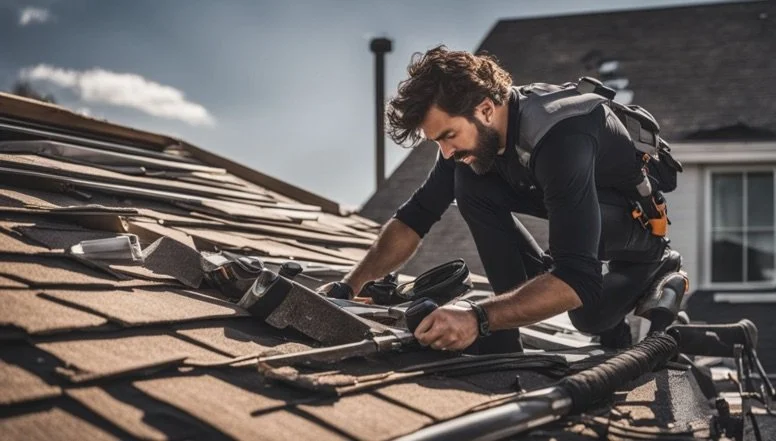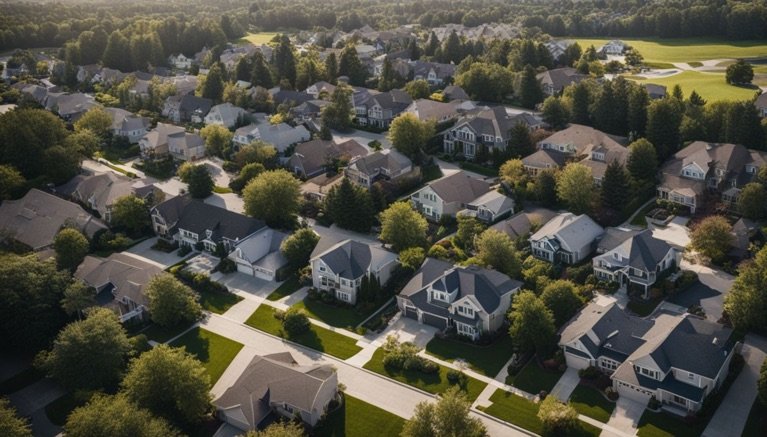When is the Right Time to Replace Your Roof?
Does your roof seem a little worse for wear or spring a leak when the rain pours? Been in that situation before, right? After conducting extensive research on this common issue, we've found that understanding when it's time to replace your roof is a key component of home maintenance.Our in-depth guide will shed light on everything from how to recognize signs of deterioration like cracked shingles, to grasping the effect a worn-out roof can have on energy bills.Eager to get some expert insight that could save your precious home from significant damage? Let's dive right in!Key Takeaways
Signs of roof replacement include the age of the roof, visible wear and tear, water damage, cracked or damaged shingles, and pest infestations.A damaged roof can lead to increased energy bills, mold growth inside the home, and further water penetration from damaged flashing.Asphalt roofs may need replacement if there are curling shingles or bald spots. Tile roofs may need replacement for cracked tiles or water leaks. Metal roofs have a longer lifespan but should be replaced if there is rust or loose screws.The process of roof replacement starts with a thorough inspection by a roofing professional to assess the damage and determine whether repair or replacement is needed.
Recognizing the Signs of Roof Replacement
The signs of roof replacement include the age of the roof, visible wear and tear, water damage, cracked or damaged shingles, and pest infestations.Age of Roof
The age of your roof is a key factor to think about. Most roofs last around 20 years. If your roof is nearing this age, we might need to replace it soon. Notice if close houses are getting new roofs too.It could mean our roof needs an update too! Keep in mind that taking good care of the roof can help it last longer as well.Visible Wear and Tear
Look at your roof. See if you spot any signs of damage. This could be tiles or shingles that are cracked, broken or missing. You might also see dark patches or trails on the roof. These are signs of wear and tear.Granules in the gutters is another sign to watch out for. If it rains and you see lots of little bits like sand in the gutter, this means your shingle's top layer is wearing off. You should also check for leaks inside your home, as these can show that there's a problem with your roof above.Water Damage
Water damage is a big sign that you need a new roof. Cracked shingles let water in and cause this damage. Wind can lift your shingles, which also lets damaging water into your home.We must fix leaky roofs right away to stop more harm from happening. Exposed nails are bad news too because they can lead to leaks and then water damage. Without the right gutter apron, water can wick up and ruin parts of our homes like the fascia, soffits, and roof sheathing.So we keep an eye out for these signs of trouble!Cracked or Damaged Shingles
Look at your roof now and then. You might see shingles that are cracked or damaged. This is a big sign of trouble. Cracked shingles let water in. Water can hurt your home's inside parts.Damaged shingles can also mean the roof is very old or not well-made from the start. If wind has lifted any shingles, this too hints at problems. Wind can make cracks bigger and even rip off some shingles! Another hint would be missing granules on your roof due to hail damage - this could expose the inner parts of your roof to harm by harsh sun rays and heavy rains! In these cases, it's best for us to think about replacing our roofs soon as we don't want more harm done than good.Pest Infestations
Pest infestations can wreak havoc on your roof and may require replacement. If you notice signs of pests like rodents, insects, or birds on your roof, it's important to take action.These pests can cause damage by chewing through materials, nesting in crevices, and leaving behind droppings that attract other pests. Not only do they compromise the integrity of your roof, but they can also pose health risks and lead to further issues such as water damage and mold growth.Addressing pest infestations promptly is crucial to protect your home and avoid costly roof repairs down the line.Impact of a Damaged Roof
A damaged roof can have several negative consequences for homeowners. It can lead to a noticeable increase in energy bills, as the compromised roof allows hot or cold air to escape, forcing the HVAC system to work harder.Additionally, water damage from leaks can cause mold and rot inside the home, leading to health issues and costly repairs. Damaged flashing around chimneys and other areas can also result in further water penetration.Overall, a damaged roof not only affects the aesthetic appeal of the home but also poses potential risks and financial burdens for homeowners.Noticeable Increase in Energy Bill
If you've noticed a sudden spike in your energy bill, it could be a sign that your roof needs to be replaced. Cracking shingles or wind damage can cause leaks, which in turn lead to increased energy usage as your HVAC system works harder to maintain a comfortable temperature.Additionally, roofs that are losing granules or have curling shingles may indicate poor ventilation, resulting in higher energy bills. It's important to address these issues promptly to avoid further damage and unnecessary costs.Mold and Rot
One of the impacts of a damaged roof is that it can lead to mold and rot. When water gets into your home through cracks or leaks in your roof, it can create a damp environment that is conducive to mold growth.Mold not only looks unsightly but also poses health risks, especially for those with allergies or respiratory problems. Additionally, if left untreated, the moisture can cause wood rot in your roof structure, leading to further damage and potential safety hazards.It's important to promptly address any signs of mold or rot in your roof to prevent further issues.Damaged Flashing
If you notice damaged flashing on your roof, it's important to address the issue as soon as possible. Damaged flashing can lead to water getting into your home and causing further damage.Flashing is the material that seals the edges and joints of your roof, such as around chimneys, vents, and skylights. When flashing becomes cracked or loose, it can allow water to seep underneath and cause leaks.This can result in rotting wood and structural damage if left untreated. While not all cases of damaged flashing require a full roof replacement, it's crucial to have a professional assess the extent of the damage and make any necessary repairs promptly to avoid further complications.When to Replace Your Roof by Roof Type
When it comes to asphalt roofs, if you notice curling shingles, bald spots or granules missing, it's time for a replacement. For tile roofs, cracked or damaged tiles and water leaks indicate the need for a new roof.As for metal roofs, rusted panels and loose screws are signs that replacement is necessary.Shingle Roofing
An asphalt roof is a common type of roofing material that many homeowners have. Over time, asphalt roofs can show signs of wear and tear. Cracks in the shingles or bald spots where granules are missing may indicate that your roof needs to be replaced.Additionally, if your shingles are curling or damaged, it could be a sign of leaks or poor ventilation, which may require a new roof. Hail damage can also cause problems with an asphalt roof, such as the loss of protective granules.When considering whether to replace your shingle roof, it's important to inspect it for any visible damage and consult with a roofing contractor for their professional opinion.Tile Roof
Tile roofs are a popular choice for many homeowners due to their durability and aesthetic appeal. However, over time, tile roofs can experience wear and tear that may require replacement.One sign of roof damage is when the tiles become lifted or loose due to strong winds. This can lead to water leakage and structural problems if not addressed promptly. Another factor to consider is the loss of granules on the tiles, which indicates the age of the roof and its overall condition.If you notice leaks or any signs of damage in your tile roof, it's important to take immediate action to prevent further issues such as rotting sheathing or framing. Proper flashing around chimneys is also crucial for maintaining a healthy tile roof.Metal Roof
Metal roofs are a great option for replacement because they have a longer lifespan of 40-70 years. They can withstand strong winds better than other roof types, and there's no need to worry about cracked or curled shingles.Metal roofs also don't lose granules over time like other materials, which means less maintenance. With their durable construction, metal roofs are less prone to leaks and water damage.So if you're considering replacing your roof, metal is definitely worth considering for its longevity and durability.The Process of Roof Replacement
Once you've determined that your roof needs to be replaced, the process begins with a thorough inspection by a roofing professional. They will assess the damage and provide recommendations for repair or replacement.Read on to learn more about this essential step in ensuring the longevity of your home's roof.Inspection
Before deciding if it's time to replace your roof, a thorough inspection is necessary. Look for signs of cracked or damaged shingles, as well as any visible wear and tear. Check for water damage or leaks in the attic or ceilings.Examine the age of the roof and consider its overall condition. Curling shingles may indicate bigger problems like leaks or poor ventilation. Additionally, exposed nails can lead to a leaky roof that might require replacement.It's important to carefully assess these factors before making a decision about replacing your roof.Repair Vs. Replacement
Sometimes, when your roof starts showing signs of damage, you might be wondering whether it's better to repair it or replace the whole thing. Well, that depends on a few factors. If your roof has minor issues like a few cracked shingles or small leaks, a repair might be enough to fix the problem.However, if your roof is old and worn out, with multiple areas of damage or extensive water infiltration, then replacement may be necessary. It's important to consider the overall condition of your roof and consult with a professional to determine the best course of action.Advantages of Roof Replacement
Replacing your roof comes with several advantages that can greatly benefit you and your home. First and foremost, roof replacement ensures the safety and protection of your property.By getting rid of damaged shingles, cracks, or leaks, you can prevent further issues such as water damage or mold growth inside your house. This not only saves you from costly repairs down the line but also improves the overall health and quality of your living space.Additionally, a new roof enhances the energy efficiency of your home. Older roofs may have poor insulation or ventilation, causing drafts and temperature fluctuations inside. By replacing your roof with modern materials that offer better insulation properties, you can create a more comfortable environment while reducing energy consumption and lowering utility bills.Another advantage is improved curb appeal. A worn-out or damaged roof can significantly detract from the appearance of your home's exterior. A new roof instantly boosts its overall aesthetics by providing a fresh, clean look that adds value to the property.Furthermore, investing in a new roof gives you peace of mind knowing that it will last for many years to come. Modern roofing materials are designed to be durable and long-lasting, offering increased resistance against harsh weather conditions like strong winds or heavy rain.Overall, replacing your roof not only protects your home but also provides financial benefits in terms of increased energy efficiency and improved property value. It's a worthwhile investment that ensures both practicality and visual appeal for years ahead.Conclusion
Knowing when to replace your roof is crucial in maintaining the integrity of your home. Signs such as cracked shingles, wind damage, and exposed nails indicate the need for replacement.Leaks should be fixed promptly to prevent further damage. Trust a professional roofing contractor to assess your roof and determine if it's time for a replacement. Taking proactive steps will ensure that your roof continues to protect you and your family for years to come.FAQs
1. What are signs that I need a roof replacement?
You might need a roof replacement if you see damaged shingles, cracked shingles, or have leaks in your roof. Other signs are missing granules and exposed nails.2. How does age impact the need for roof replacement?
Roof age plays a big part in knowing when to replace your roof. An old asphalt shingle roof often shows issues like curling shingles, loss of granules, and cracks.3. Why is it important to fix bad chimney flashing and loose step flashing on my roof?
Bad chimney flashing and loose step flashing can cause water damage by making your roof leak. Fixing these problems helps avoid costly roofing projects later.4. Can weather conditions affect my decision for a new roof?
Yes! Wind damage, hail damage or storm damage could ruin parts of your roofing system quickly making you think about getting a new one right away.5. What is the role of an independent roofing contractor during the process of replacing roofs?
An Independent Roofing Contractor helps inspect your whole roofing system including attic insulation, ventilation etc., for potential issues before starting any re-roof project as per Owens Corning Roofing standards6. Does algae harm my shingles? How can I get rid from them?
Algae on top can stain roofs but doesn't harm the life or working of good quality Algae-resistant Shingles which contain copper strips that stops growth then cleaning those dark streaks caused by airborne algae with help from exterior home design resources should keep things under control.<script type="application/ld+json">
{
"@context": "https://schema.org",
"@type": "FAQPage",
"mainEntity": [
{
"@type": "Question",
"name": "What are signs that I need a roof replacement?",
"acceptedAnswer": {
"@type": "Answer",
"text": "You might need a roof replacement if you see damaged shingles, cracked shingles, or have leaks in your roof. Other signs are missing granules and exposed nails."
}
},
{
"@type": "Question",
"name": "How does age impact the need for roof replacement?",
"acceptedAnswer": {
"@type": "Answer",
"text": "Roof age plays a big part in knowing when to replace your roof. An old asphalt shingle roof often shows issues like curling shingles, loss of granules, and cracks."
}
},
{
"@type": "Question",
"name": "Why is it important to fix bad chimney flashing and loose step flashing on my roof?",
"acceptedAnswer": {
"@type": "Answer",
"text": "Bad chimney flashing and loose step flashing can cause water damage by making your roof leak. Fixing these problems helps avoid costly roofing projects later."
}
},
{
"@type": "Question",
"name": "Can weather conditions affect my decision for a new roof?",
"acceptedAnswer": {
"@type": "Answer",
"text": "Yes! Wind damage, hail damage or storm damage could ruin parts of your roofing system quickly making you think about getting a new one right away."
}
},
{
"@type": "Question",
"name": "What is the role of an independent roofing contractor during the process of replacing roofs?",
"acceptedAnswer": {
"@type": "Answer",
"text": "An Independent Roofing Contractor helps inspect your whole roofing system including attic insulation, ventilation etc., for potential issues before starting any re-roof project as per Owens Corning Roofing standards."
}
},
{
"@type": "Question",
"name": "Does algae harm my shingles? How can I get rid from them?",
"acceptedAnswer": {
"@type": "Answer",
"text": "Algae on top can stain roofs but doesn't harm the life or working of good quality Algae-resistant Shingles which contain copper strips that stops growth then cleaning those dark streaks caused by airborne algae with help from exterior home design resources should keep things under control."
}
}
]
}
</script>




